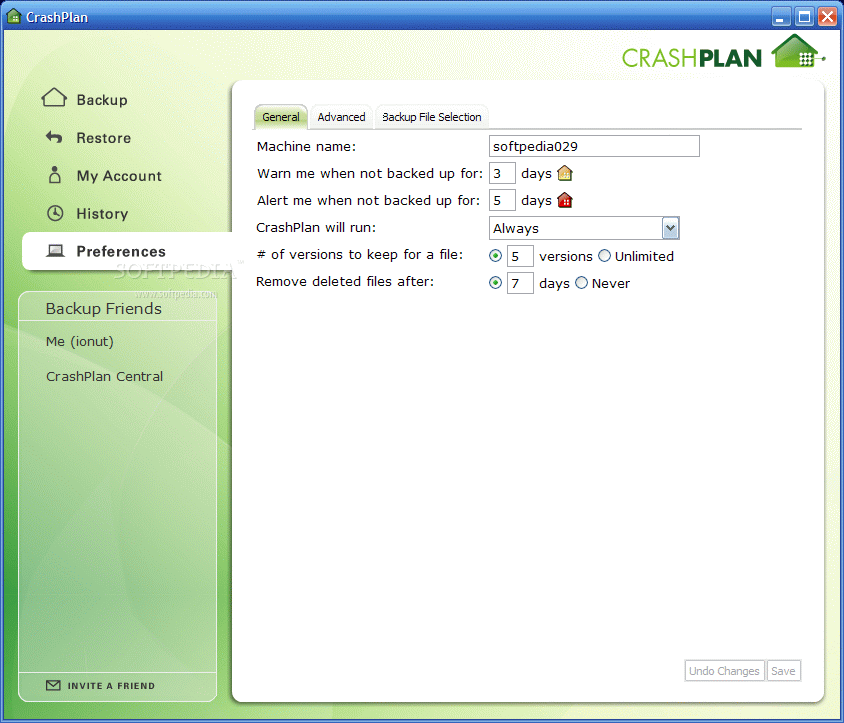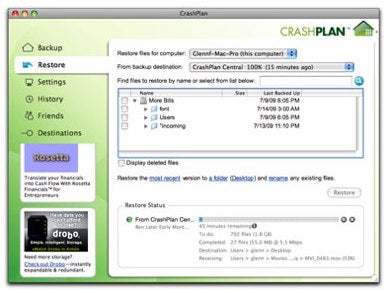

For JDK 6 before the 6u23 release, use the -XX:+UseCompressedOops flag.I have a PC with Windows 10 and have several attached HD with a collective data of about 40TB (lots of music/videos). In Java SE 7, use of compressed oops is the default for 64-bit JVM processes when -Xmx isn't specified and for values of -Xmx less than 32 gigabytes. Compressed oops is supported and enabled by default in Java SE 6u23 and later. In 32-bit it should read around 140MB, it won't go over that.įor Linux, stay on 64-bit (if you have a 64-bit cpu), lower the memory maximum, and use compressed ops.
CRASHPLAN MEMORY MAC OS X
In Mac OS X 64-bit if you set " -Xmx" to 100MB, your "real memory" usage will read about 150/180MB. If you notice that CrashPlan is using too much memory while backups are running fine, you may also reduce the memory assignment to 384, 256, 150, 128, 100, 80 or even 50 for small backup sets. Especially on 64-bit systems it might be possible to go higher, for example 4096. You should be able to increase it to 1536 or 2048 on 32-bit systems. If you still have the problem, change the setting to a higher value. $ sudo launchctl load /library/launchdaemons/ This will allocate 1024MB of memory instead of the default 512MB. Find -Xmx512m, for example by using Ctrl+ W.Now edit the plist file using a text editor, for example:.You will be asked for your admin password. $ sudo launchctl unload /library/launchdaemons/

Look for the following setting: -Xmx512m.Open Windows Explorer and browse to C:\Program Files\CrashPlan and double-click the CrashPlanService.ini file.On most Windows computers this is in the „ Control Panel > Administrative Tools > Services” Make sure your computer has enough memory (RAM/SWAP) before you make this change. This will increase the amount of memory that CrashPlan can use to 1024MB. CrashPlan will not use that much until it needs it.Īs a rule of thumb set about one gigabyte (=1024 MB) RAM for every terabyte in the file selection.įor example, if you're backing up 1 terabyte of data set the " -Xmx" value to 1024 like so: -Xmx1024m. The " -Xmx" switch sets the maximum amount of memory that CrashPlan can use. /usr/local/crashplan/bin/run.conf « Linux.C:\Users\ \AppData\ \Programs\CrashPlan\CrashPlanService.ini « Windows with a per user CrashPlan installation.C:\Program Files\CrashPlan\CrashPlanService.ini « Windows.SolutionĪllocate more memory to CrashPlan. When the CrashPlan engine is running out of memory it crashes. The CrashPlan engine won’t use more memory than that, even if the CrashPlan engine needs more working memory and the computer has memory available. The CrashPlan engine by default is limited to 512MB of main memory. In one of the CrashPlan service.log.# log files will appear "OutOfMemoryError" messages, like: ERROR QPub-BackupMgr ] OutOfMemoryError occurred.RESTARTING! message=OutOfMemoryError in BackupQueue! ERROR QPub-BackupMgr ] OutOfMemoryError occurred.RESTARTING! oomStack=: Java heap space Cause In the Windows System Event Viewer you may see this message repeatedly: Event Type: Informationĭescription: The CrashPlan Backup Service service entered the stopped state. When starting and stopping in the CrashPlan application its History tab, you may repeatedly see CrashPlan stopped and started: CrashPlan log file service.log.0 will show: : Unable to load library 'cpnative64': The specified module could not be found. When the UI is crashing no error message will show up in the Windows event log. After launching the Crashplan GUI, itwill run for a little bit, hang and then finally crash. Or the main CrashPlan program will run for about 30 seconds then close down with no error message. You may also see the CrashPlan version 2010 application and System Tray icon disappearing in the middle of a backup. This can be noticed by continuous stopping and starting.

In some cases a large file selection (>1TiB or 1 million files) can cause CrashPlan to crash.


 0 kommentar(er)
0 kommentar(er)
